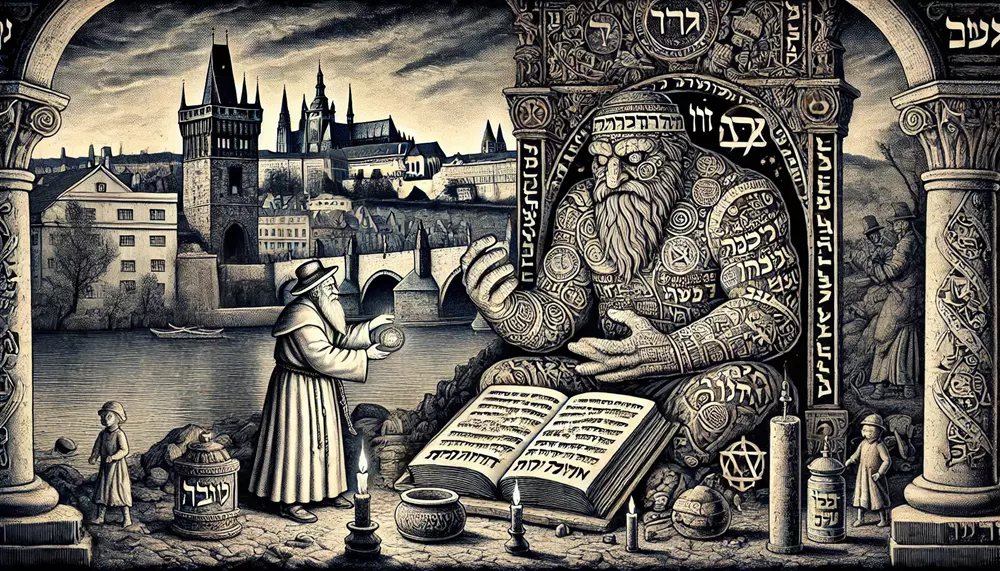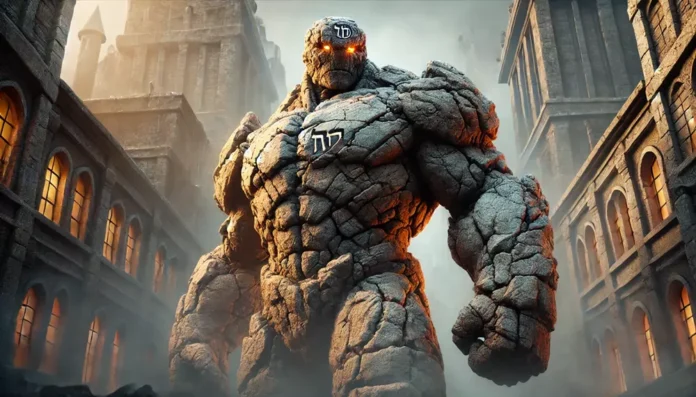Golem: The Protector of the People
The Golem is a fascinating figure in Jewish folklore, known for its role as a guardian and protector. Crafted from inanimate materials like clay or mud, the Golem is brought to life through a sacred ritual, often involving the inscription of Hebrew letters or prayers. Although its primary purpose is to serve and protect, the Golem’s raw power and lack of independent will make it a potentially dangerous entity. Over centuries, the Golem has become a symbol of Jewish resilience, as well as a reflection on the ethics of creation and the boundaries of human control.
Origins and Mythological Background
The Golem’s origin is deeply intertwined with Jewish mysticism, particularly Kabbalah. The word “Golem” itself derives from a Hebrew term meaning “shapeless mass” or “unfinished substance,” which is used in the Talmud to describe an unformed entity. While stories of the Golem have existed for centuries, its most famous tales are rooted in medieval Europe, where it served as both a protector of Jewish communities and a cautionary tale about the consequences of overstepping divine limits.
The Golem of Prague
The most iconic Golem story is that of Rabbi Judah Loew ben Bezalel, known as the Maharal of Prague, who is said to have created a Golem in the 16th century to protect the Jewish community from anti-Semitic attacks. According to legend, Rabbi Loew formed the Golem from the clay of the Vltava River and brought it to life by inscribing the Hebrew word emet (meaning “truth”) on its forehead. The Golem served as a defender against those who would harm the Jewish people, using its great strength to repel attacks and prevent blood libel accusations.

However, the Golem’s power soon became a source of concern. In some versions of the story, the Golem grows increasingly aggressive, threatening innocent lives. To prevent further harm, Rabbi Loew erases the first letter of emet, changing it to met (meaning “death”), thereby deactivating the Golem. The Golem is then returned to the earth, awaiting the day when it may be called upon again.
Cultural Impact and Evolution
The Golem has held a prominent place in Jewish culture, symbolizing protection, creativity, and the moral complexities of power. Its legend has resonated through the centuries, influencing not only folklore but also literature, art, and popular culture.
The Golem as a Symbol of Protection
For Jewish communities facing persecution, the Golem represented hope and strength. The tales of the Golem often reflect the realities of living in a world fraught with danger, where the need for protection was both immediate and ongoing. The Golem’s lack of a soul and its dependence on its creator highlight the idea of sacrificial guardianship — a being without personal desires or ambitions, solely dedicated to the wellbeing of the community. The Golem’s story also served as a means of fostering solidarity among Jewish people, uniting them around a common protector in the face of external threats.
Ethical Implications and the Limits of Power
The Golem legend raises important ethical questions about the nature of creation and the responsibilities of those who wield power. As a creature animated by mystical forces, the Golem embodies the tension between human agency and divine authority. The fact that Rabbi Loew had to deactivate the Golem when it became dangerous speaks to the moral hazards of overreaching and creating life without the means to fully control it. This theme has been echoed in many later works, from Mary Shelley’s Frankenstein to modern discussions on artificial intelligence, where creators grapple with the implications of their creations turning against them.
Symbolism and Archetypes
The Golem serves as a potent archetype of the obedient yet potentially uncontrollable servant. It reflects the human desire to shape the world through creation, balanced against the dangers of that ambition. As a creature of earth, the Golem also represents themes of grounding and the relationship between humanity and nature.
The Golem as the Second Adam
In Jewish mysticism, the Golem is sometimes referred to as Adam Sheini, or “Second Adam.” This moniker links the Golem to the biblical story of creation, wherein God formed the first man, Adam, from dust. Just as Adam was animated by divine breath, the Golem is given life through sacred rituals. However, unlike Adam, the Golem lacks a soul and free will, which underscores its status as a lesser creation — a reflection of humanity’s limitations in emulating the divine act of creation. This distinction also emphasizes the idea that the Golem, while powerful, is incomplete, a creature that exists on the boundary between life and non-life.
Modern Representations in Popular Culture
The Golem’s enduring appeal has made it a staple in literature, film, and other forms of media, where it is often reimagined in new contexts that reflect contemporary concerns and aspirations.
Literature and Film
The Golem has inspired numerous novels and films that explore themes of creation, power, and the dangers of hubris. Gustav Meyrink’s novel The Golem (1915) reinterprets the legend in a psychological thriller set in the Jewish ghetto of Prague, where the Golem becomes a mysterious, almost ghostly figure. This novel, along with other early 20th-century works, helped establish the Golem as a symbol of mystery and the unknown.
In film, the Golem has appeared in a variety of forms, from the German silent horror film The Golem: How He Came into the World (1920), which explores the creature’s origins, to more recent adaptations that blend horror, fantasy, and drama. These portrayals often focus on the Golem’s dual nature as a protector and a potential menace, playing on the fear that even the most well-intentioned creations can spiral out of control.
Comics, Video Games, and Modern Media
The Golem has also found a place in comic books, video games, and other modern media. In comic book series such as The Amazing Adventures of Kavalier & Clay by Michael Chabon, the Golem is reimagined as a superhero figure. In video games, Golems often appear as powerful allies or enemies, drawing on the creature’s mythic strength and mystical origins.
In popular culture, the Golem has been adapted into various forms that resonate with contemporary themes. For example, the Golem is often portrayed as a robot or automaton, linking it to current discussions about artificial intelligence and the ethical challenges of creating life-like machines. These adaptations reflect society’s ongoing fascination with the idea of controlling creation and the risks associated with wielding such power.
Conclusion
The Golem remains a powerful symbol of protection, ambition, and the ethical questions that arise when humans seek to emulate divine creation. Its story has been retold and reimagined across centuries, each time resonating with the concerns and hopes of the era. As a guardian, the Golem reflects humanity’s desire for security, while as an uncontrollable force, it serves as a cautionary tale about the limits of power. Through its many forms and interpretations, the Golem continues to capture the imagination, embodying both the strength and the vulnerability of human creation.Goylem, Galmi, Adam Sheini (meaning “Second Adam” in Hebrew)




